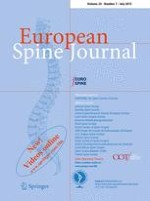Erschienen in:

01.07.2015 | Original Article
Skipped versus consecutive pedicle screw constructs for correction of Lenke 1 curves
verfasst von:
Simon Morr, Alexandra Carrer, Luis Ignacio Alvarez-García de Quesada, Juan Carlos Rodriguez-Olaverri
Erschienen in:
European Spine Journal
|
Ausgabe 7/2015
Einloggen, um Zugang zu erhalten
Abstract
Purpose
Thoracic pedicle screws provide superior curve correction to hook and wire constructs in adolescent idiopathic scoliosis, while increasing cost. The number of implants required for best correction and outcome has not yet been determined.
Methods
We retrospectively reviewed pre- and post-operative radiographs and self-reported outcome measures in an age- and curve-matched cohort of 40 patients with Lenke I AIS who underwent selective fusions between T3/4 and L1. Twenty patients were treated with thoracic pedicle screws at every level bilaterally (CON) and 20 patients with screws at every level on the concave side and skipped levels on the convex side of the curve (SKP). All patients had a minimum 2-year follow-up. Radiographs were assessed for coronal and sagittal curvatures, as well as thoracic torsion and vertebral rotation. Health-related quality of life was assessed using the SRS-22 instrument. Instrumentation cost data were collected for each case.
Results
Postoperative follow-up averaged 28 months for the CON group and 29 months for the SKP group. No statistically significant differences were found between groups with respect to age and pre- and post-operative radiographic parameters. Both constructs provided acceptable correction of the main thoracic curves (66.9 vs. 66.6 %, CON group and SKP group, respectively; p = 0.92), and spontaneous correction of the proximal thoracic (41.5 vs. 41.1 %; p = 0.92) and thoracolumbar/lumbar curves (54.8 vs. 54.3 %; p = 0.92). No significant difference was found in postoperative SRS-22 scores (96 vs. 94.3; p = 0.34). The CON group cost for instrumentation was significantly higher than the SKP group ($19,500 vs. $13,300; p = 0.002). There was no statistically significant difference in operating room times between groups.
Conclusion
Both construct types provide excellent coronal correction and sagittal balance, with no significant differences in radiographic findings or clinical outcomes. A significant decrease in cost was found with use of skipped screw constructs.